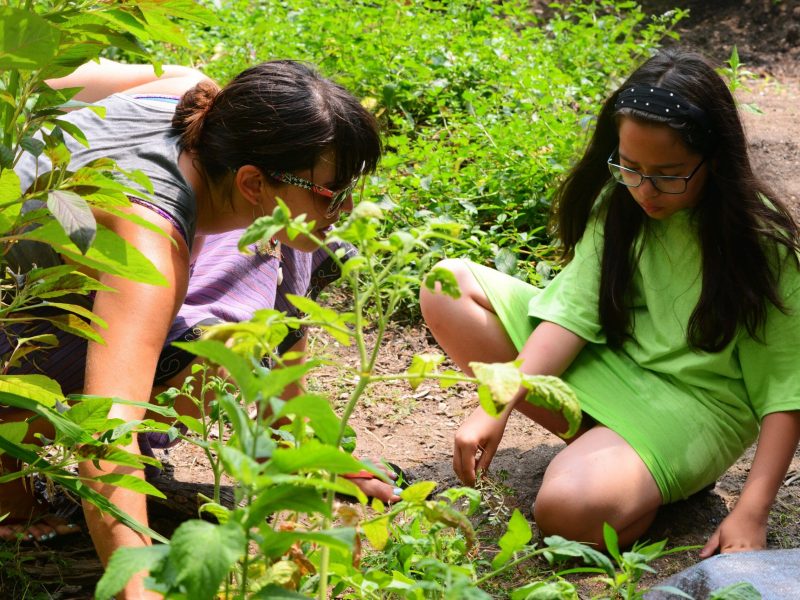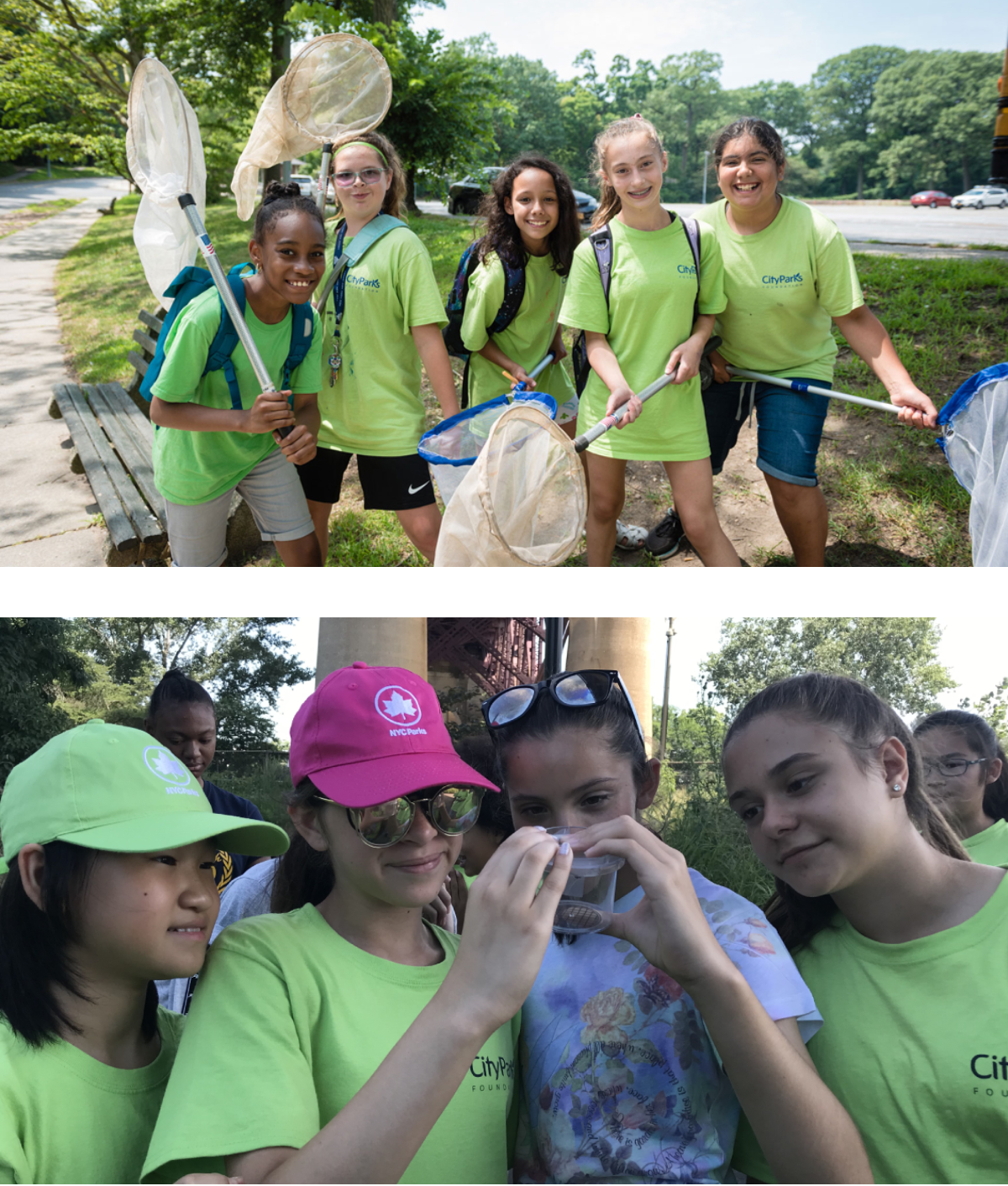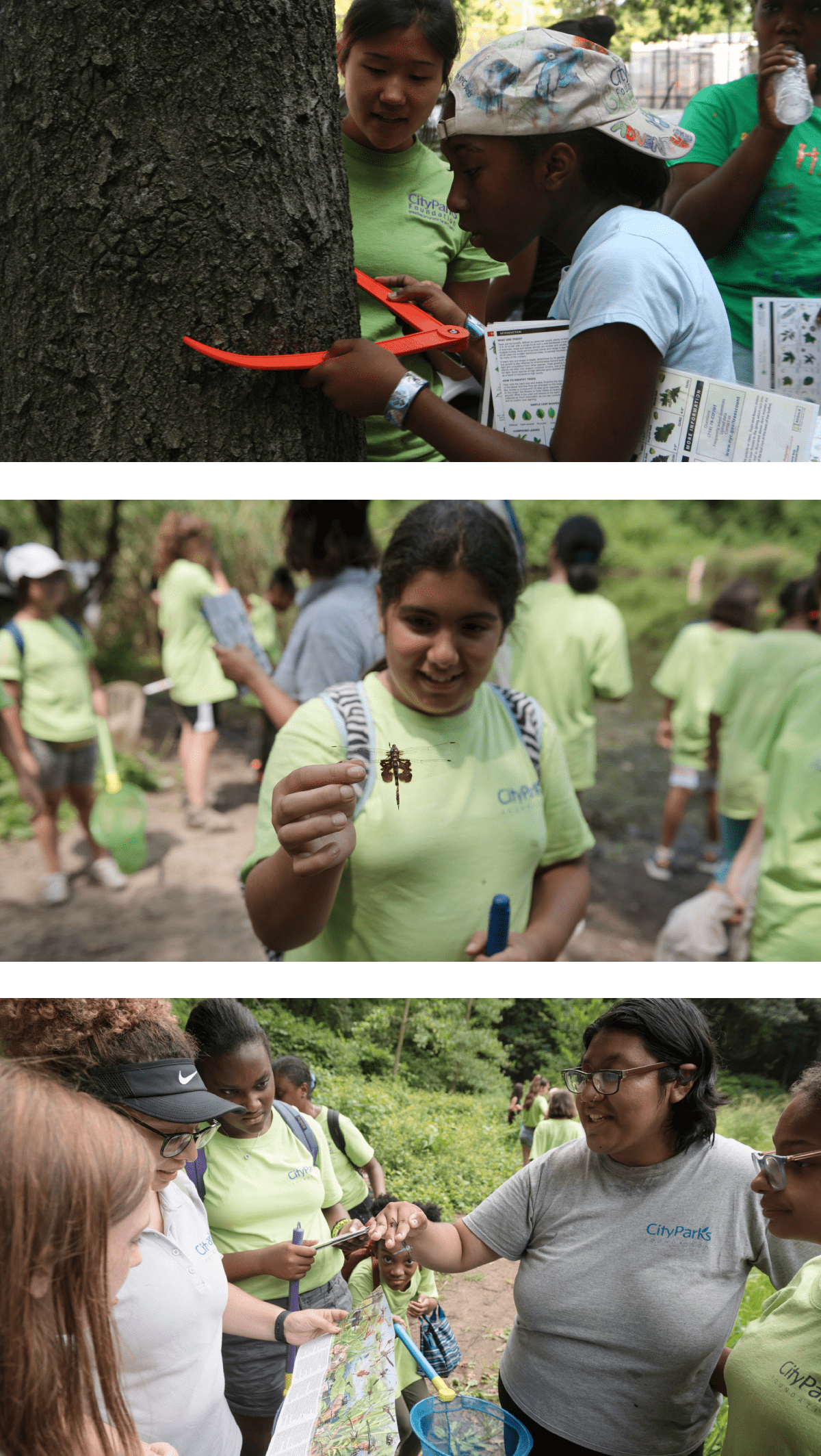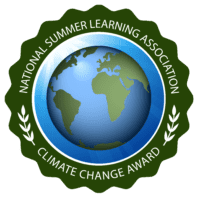We are very excited to share the CityParks Green Girls curriculum beyond New York City’s borders. Since the program’s inception almost 20 years ago, thousands of Green Girls in their middle and high school years have had the opportunity to learn about our local natural environment as involved citizens and to see themselves as future scientists and leaders. Plenty of those young girls started the program with cynicism about nature in New York City and many would have said that it was non-existent. Those viewpoints could not withstand holding a live animal such as a frog or dragonfly, or discovering rare and peaceful beauty in the acre upon acre of forests, ponds, streams and shorelines that comprise New York City’s parklands. These are the areas that New Yorkers are surprised to learn about and the ones with which we have made sure that our Green Girls become very familiar. Why? Because familiarity breeds curiosity. Curiosity engenders a desire to know more. Knowing more can shift one’s attitude from apathy to affection and that affection will inspire a person to act. That’s been our goal on this journey – to guide our girls to act for themselves as they grow to understand their own abilities to learn and participate in science as well as effect change for their local environment.
We look forward to the next leg of this journey with you through a curriculum that has been adapted for any locale, as you inspire your students and children to be curious, to learn and to act!
Alarmed by the scarcity of science programs for girls and the evidence of girls’ lagging science scores, City Parks Foundation created Green Girls in 2002 to focus on getting young women of color from under-resourced neighborhoods interested in science. A substantial gender gap exists in the science classroom: 2008 data from the National Assessment of Education Progress (NAEP) shows that, while boys and girls start out with equal levels of interest and engagement, by the time they reach age 10, boys score significantly better in math and science than girls; the 2007 Trends in International Mathematics and Science Study also shows that eighth-grade boys continue to outperform girls in all areas of science, and that students of color and those living in communities with higher poverty levels are most at risk for low science achievement. While the NAEP data recorded in 2015 shows a narrowing of the gender gap, the data still indicates a significant disparity in test scores between white students and African-American or Hispanic students. Further, the UNESCO Institute for Statistics estimates that “less than 30% of the world’s researchers are women” signaling that while the achievement gap is narrowing, the opportunity gap has not.
As the Green Girls program evolved, it became apparent that the students needed much more than just science instruction and activities to become engaged in our program. In the out-of-schooltime arena, girls need more than academics and we found early on that our students had issues with confidence and attitude toward science, as we often heard the refrain “I’m not good at science”. We needed to build confidence and a safe space before we could reach our goals in environmental science learning and advocacy. Green Girls became an after school club that integrated team building, socio-emotional learning and female empowerment. When these elements became part of the science-learning equation, we saw our students flourish in unexpected ways. They support one another, develop lasting friendships and show great ability to work together.


Socio-emotional learning (SEL) promotes student-centered programming and allows students to take initiative; helps students develop skills to work independently and in teams; builds leadership skills, as well as self- and social awareness; and encourages healthy relationships between students and with their peer mentors. There are many online resources that help educators get started in their SEL training. (One such example is provided by CASEL, the Collaborative for Academic, Social and Emotional Learning.) As part of the Green Girls curriculum, socio-emotional core competencies are built into every lesson in intentional ways and in practice. Students come to understand and learn to articulate their own self-determination and the ways that they can encourage one another through collaboration, conflict resolution and supportive feedback. Each Green Girls lesson begins with an intentional SEL activity. Practice is built into the rest of the lesson through examples such as “Time For Applause!” in which students take a moment to reflect on their own contributions and by giving each other positive affirmation. This also fosters a group environment in which students are comfortable, feel they belong, and develop a lasting affection for each other and the program itself.
We believe that students can learn more from each other than they can from their teachers. As educators, we are their guides, not the gatekeepers of knowledge who reward passive listening and rote repetition. When students, especially those in middle and high school, are given opportunities to work together, speak to each other, explore independently in pairs or small groups, express ideas and choose their own paths of learning, they get excited to learn. To monitor how we’re doing as guides, we developed a rubric that helps us measure our effectiveness in stating clear objectives, allowing for student voice and exploratory hands-on learning, guiding student engagement through independent work, assisting students to make or recognize connections, implementing clear assessment of student learning, and articulating outcomes with the students.
Place-based education is a pedagogical philosophy that has been widely adopted by many environmental education institutions, and is defined in a number of ways. Wikipedia describes it as “education [that] seeks to help communities through employing students and school staff in solving community problems. Place-based education differs from conventional text and classroom-based education in that it understands students’ local community as one of the primary resources for learning.”
Another angle within the place-based pedagogy accounts for the lack of contact with nature, particularly in urban centers. Richard Louv issued a clarion call with his 2005 book Last Child in the Woods: Saving Our Children from Nature Deficit Disorder, and went so far as to state that a lack of experiences in nature is harmful to childrens’ psychological and physical development. Louv’s work and other influences have sparked a movement. Highly respected universities around the world now dedicate majors and entire departments to environmental education and are charged with ensuring opportunities for their students to experience and benefit from place-based education.
There’s a strong rationale for this emerging consensus. A recent article in the scientific journal Nature asserts that “Extensive ecosystem restoration is increasingly seen as being central to conserving biodiversity and stabilizing the climate of the Earth.” 1 While much of this restoration will take place outside of cities, just as much will happen within urban forests and waterways, and opportunities for scientific learning and training will increase in cities. Green Girls is on the cutting edge of this movement, and has been for a number of years. The “real-world” training aspect of our program gives our students the chance to meet and interact with professionals and activists who are working to conserve and restore our city’s natural resources. We do this primarily through adoption of local areas in which students get to know and help restore their urban “backyards” through service-learning activities.
Advocacy training is another vital component of our curriculum. The Green Girls are not only learning the value of clean water and healthy street trees, but are also proactively advocating for these causes in their own communities and city. By practicing writing their elected officials, preparing draft plans of parks restoration projects and attending public rallies, the students are gaining the knowledge and confidence to engage in political action and influence real-world outcomes.
1 Global Priority Areas for Ecosystem Restoration; https://www.nature.com/articles/s41586-020-2784-9?mc_cid=bbdc261dc4&mc_eid=2762f93b1a
The Green Girls program could not be successful without the support of our partners. Scientists, educators, technicians, urban planners and farmers in organizations such as NYC’s Department of Parks and Recreation (NYC Parks), the Bronx River Alliance, an environmental organization protecting the Bronx River corridor, and Trees NY, a nonprofit that focuses on protecting our city’s urban forest, among others, have made it possible for our students to experience place-based education that inspires them to create positive change through service. Without these partnerships, we would not have the capacity or opportunities to perform service where it’s needed, nor would our students have the opportunity to learn from subject experts about the environmental needs of our city. Partnerships enable authentic experiences and those experiences spark interest and passion in our students.
Where to begin? We start by identifying an area or project and then reach out to some of the leading scientific or other agencies that would have information to help us plan a service activity. In parks, we almost always first contact the NYC Parks’ Stewardship division. Your own community’s parks agency may already have a service project planned for the park in your area or they may plan something unique with your group. Another route is to reach out to local nonprofit agencies dedicated to specific subjects, such as the local Audubon chapter or, in NYC, the Billion Oyster Project, which restores local oyster reefs. These organizations lead restoration and conservation initiatives and can put your girls’ service learning hours to productive use. Through creative collaboration, students become an essential part of the work while also developing their own science and stewardship skills along the way.

Each lesson in the Green Girls curriculum includes the recommended duration, purpose (or objective), standards, materials, background information, notes on preparation, and a suggested daily agenda or Session Routine. It is important to read through the entire lesson before beginning the preparation.
Our curriculum utilizes a backwards design model to structure lessons. For each lesson topic, the essential questions point to a big picture concept. These essential questions and the purpose are written first, and then the journal prompts, activities and projects are selected and adapted to help students answer these questions.
The Session Routine is a tool that helps to build socio-emotional and science skills by formalizing routines that allow students to take control of their own learning through consistent practice with each aspect of the program. As students build knowledge and skills with each step of the daily routine, they feel increasingly comfortable participating, and more student voices make for a richer learning experience.
Session Routine
| Activity | Time | Description |
|---|---|---|
| Opening Circle | 15 min. | Introduce the Day + Journal Prompt |
| SEL Activity | 40 min. | The Dragonfly Life Cycle Show + Lecture! |
| Hands on Learning Part 1 | 40 min. | Dragonfly Survey |
| Hands on Learning Analysis | 20 min. | Data and Article Review |
| Closing Circle | 5 min. | Debrief Questions and Discussion |
A note on timing adaptations: You do not need to complete the entire lesson in one meeting. While the Session Routine outlines what should happen at each meeting (Circle Up, Journal, Activity, Reflection, Closing Circle), the activities can be done at separate meetings, thereby extending the lesson over a number of days. In this case, we suggest that the instructor spend part of the Opening Circle of each session asking girls to speak about what they learned during the previous meeting. This can be as a whole group or in pair/triad/share groups.
Formatted to prompt authentic discussion, the guided journal entry at the beginning of most lessons allows students to collect their thoughts, identify a topic they know or that they want to learn, and express how they feel and why. Putting thoughts into words serves to enhance girls’ confidence and ability to discuss the topic. The journal can also be used at other times to record observations and data, to make field drawings or to collect natural artifacts (leaves, seeds, etc.).
Activities include games, science labs, data collection, service learning and project work. They are scaffolded and structured to allow students to learn new concepts, think, act, reflect and synthesize their knowledge around the major themes presented in the lesson as a whole. Activities bring the concepts to life, helping students develop factual knowledge, build procedural knowledge through hands-on practice, and decide how to integrate this knowledge into their own lives through advocacy.
Guiding questions that are related to the scientific or socio-emotional aspects of the program will help students to synthesize concepts, commit their experiences to memory, and express their feelings about the work they’ve done: Why should I care? What did I contribute to the process? How do I make changes in the world around me? A primary goal in student-centered learning is to have the students articulate their experiences through presentations as a way to guide their own learning. As students reflect – in pairs or in small or large groups – they assist each other in developing language to describe the work and in turn understand more deeply the concepts they have put into practice.
Assessment helps teachers to understand where improvements are needed, what aspects of the lesson were not understood and need to be revisited, and what students learned overall. In each lesson, we make recommendations for both formative and summative assessment tools. Formative assessments such as exit tickets, review of data or work sheets and journal entries give teachers insight into what content students mastered at the end of each activity or lesson. Summative assessments can include pre- and post-lesson surveys and project rubrics, and tell us what was learned overall or what change has taken place in student knowledge and understanding over time. For each lesson, we have provided suggestions and samples for all of these.
Click on each module to access the lessons in the curriculum.

Thank you for taking the time to learn about the Green Girls curriculum. Your participation is key to its success. We look forward to collaborating with you as you implement the program with your students, and invite you to share your experience so we can integrate your feedback and improve the curriculum together.
Please don’t hesitate to reach out with any questions to education@cityparksfoundation.org.
Fair use: This curriculum contains instructional material, the use of which may not be specifically authorized by the owner. We are making such material publicly available to advance understanding of environmental education, distributing it without profit to those who expressed a prior interest in receiving the information for educational purposes. If you wish to use these materials for your own purposes that transcend “fair use,” you must obtain written permission from the owner.
No Responsibility disclaimer: The content contained in this curriculum is the intellectual property of City Parks Foundation. The organization is not liable for any damages arising from the use of this curriculum or any material contained therein, or from any action or decision taken as a result of using the information. The materials in this curriculum reflect the views of the authors, and do not constitute an endorsement of any particular educational model, lesson or product.